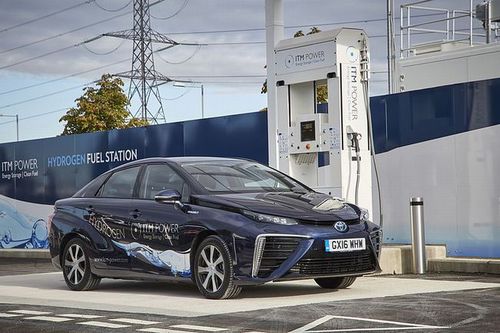June 23, 2017
Newly-developed Electrode Material Promises to Boost Volume, Cut Costs of Hydrogen Production Using Renewable Energy
Keywords: Environmental Technology

Image by Bexim Some Rights Reserved.
A research team from Japan's National Institute of Advanced Industrial Science and Technology (AIST) has developed a material for electrodes used in water electrolysis that will make it possible to produce more hydrogen than with conventional materials. The following is a report on this technology, which is expected to reduce the cost of producing hydrogen using renewable energy and improve the prospects of creating a hydrogen-based society. This article is reproduced in edited form with permission from Smart Japan, an online media services provider specializing in energy conservation, storage, and generation.
AIST announced on November 9, 2016, that it had developed a material for the positive electrodes used in solid oxide electrolyser cells (SOECs), to synthesize large amounts of hydrogen. Advantages of this material include applications in hydrogen production equipment for hydrogen refueling stations, and reductions in the size of electrolysis equipment.
Conventional water electrolysis technologies that produce hydrogen include polymer electrolyte membrane fuel cells (PEFCs) and alkaline fuel cells (AFCs), but they have limited energy conversion efficiency because their operating temperature is low and their electrolysis voltage is high. By comparison, high-temperature water vapor electrolysis using SOEC is performed at low voltage, which makes it possible to use heat less wastefully and thus to reduce by 20 to 30 percent the amount of energy needed to produce hydrogen.
A drawback of the water electrolysis technology using SOECs is the low production of hydrogen per unit of cell area (hydrogen synthesis rate). This is partly because of the high resistance generated during the reaction at the positive electrode; thus, conventional positive electrode materials have been limited in terms of electrolytic current density. Against this backdrop, the AIST research group worked to develop a material that helps achieve high current density.
For the positive electrode of SOECs, the higher its electric conductivity and the lower its electrode resistance, the higher the current density that can be achieved. Currently, perovskite-based electron-conductive material is used in the positive electrodes. When compounded with an ion-conductive material, separate conduction paths are formed for electrons and ions, reducing electrode resistance by increasing the number of points of reaction.
The newly-developed positive electrode material is comprised of nanocomposite-structured secondary particles, which are produced by homogenizing primary particles of highly electron-conductive samarium strontium cobaltite with samarium doped ceria at the nano level. The secondary particles are synthesized by a spray pyrolysis process.
Research team tests on high-temperature water vapor electrolysis using this material found that the electrolytic current density was 2.3 amperes per square centimeter (at 750 degrees Celsius operating temperature and 1.3 volts electrolysis voltage), two to ten times higher than existing technologies. This density exceeded the baseline level for practical applications and makes it possible to develop smaller electrolysis equipment.
An SOEC using this new material achieved more than double (per cell area) the synthesis rate of electrolytic hydrogen compared to PEFCs and AFCs. That means it can produce much more hydrogen and could help reduce the cost of hydrogen production using renewable energy. The team intends to continue research and development, including demonstration tests, toward practical applications.
Source: Smart Japan (in Japanese)
Related
"JFS Newsletter"
Related
"Popular Articles"
- New Nano-Bubble Technology May Help Dissolve Sludge and Improve Water Quality
- Japanese Firm Begins Development of Tidal Power Generation System
- Small Hydropower Generation System Developed for Use in Seawater, Weight Cut by Half
- Constructed Wetland Facility Established by Japanese University Purifies Livestock Farming Drainage
- Toyota CRDL Succeeds in World's First Artificial Photosynthesis Using only Water and CO2


